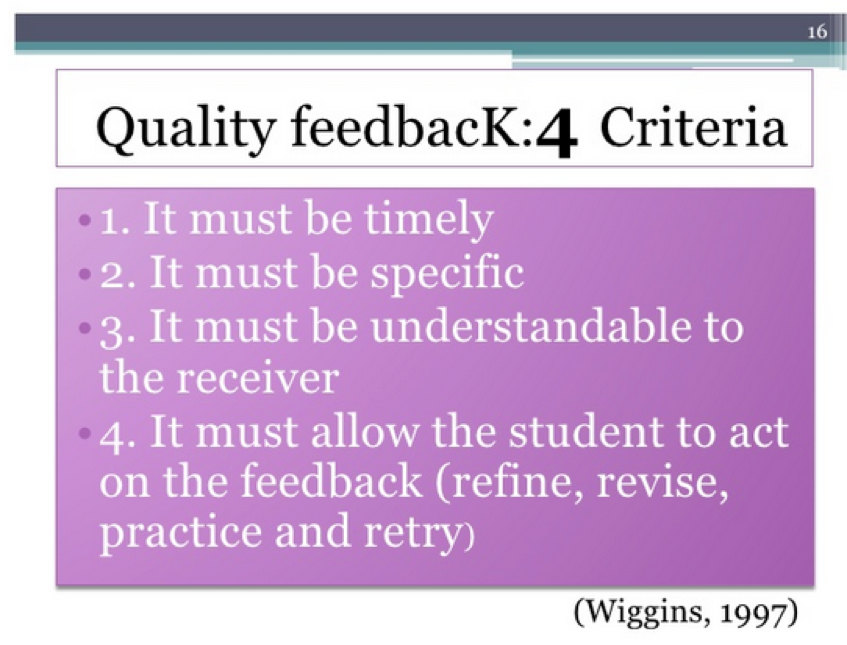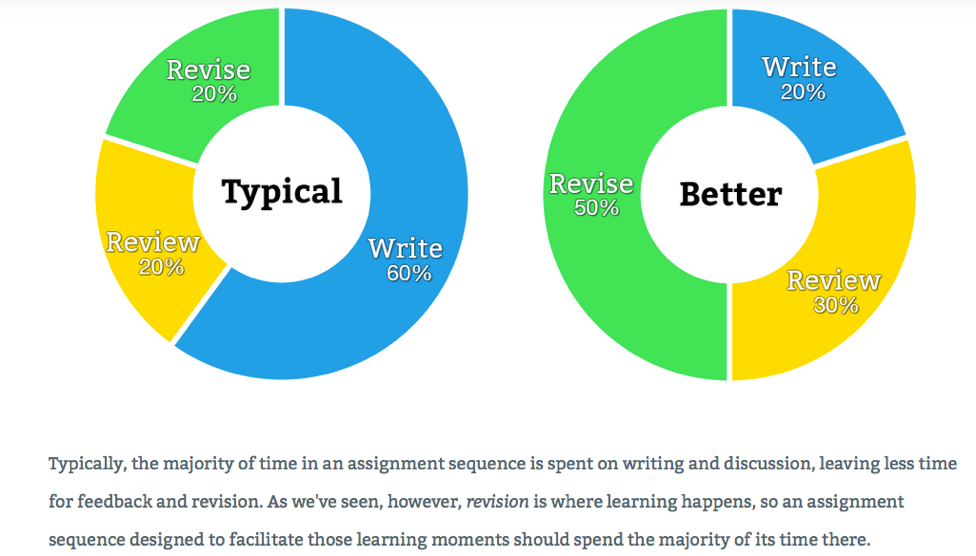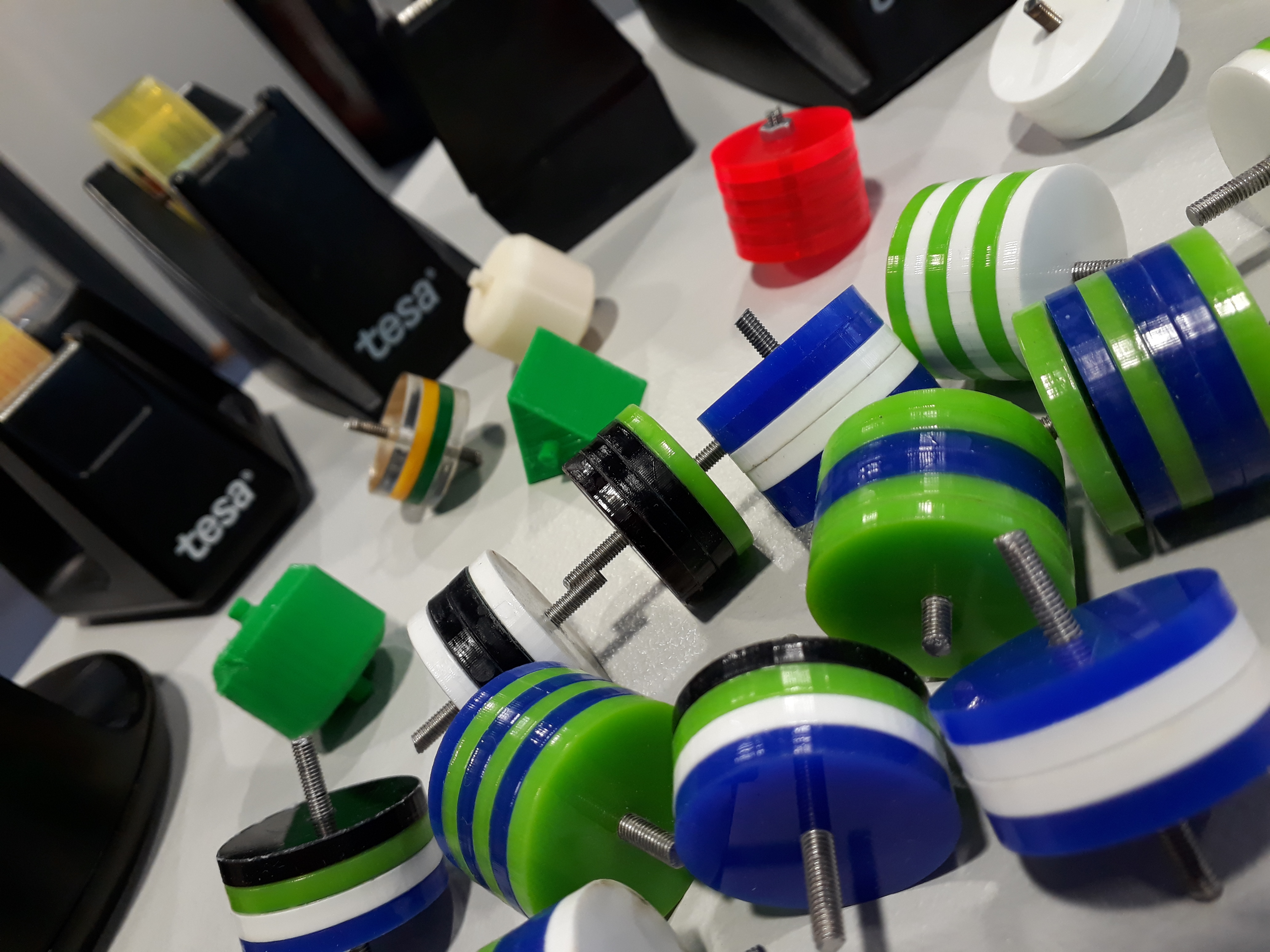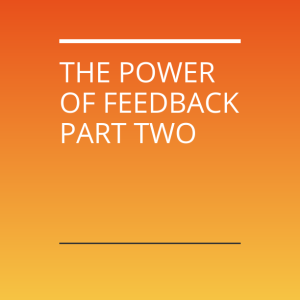 In parts one and two of my posts of John Hattie’s and Helen Timperley’s The Power of Feedback, I gave a summary of the meta-analysis. I still feel reading the entire document is worth your time, but if you want shorter synopses, go to those posts. Now, I just want to share some final takeaways from the white paper and begin to make some connections to other sources I have been exploring to improve my feedback to students.
In parts one and two of my posts of John Hattie’s and Helen Timperley’s The Power of Feedback, I gave a summary of the meta-analysis. I still feel reading the entire document is worth your time, but if you want shorter synopses, go to those posts. Now, I just want to share some final takeaways from the white paper and begin to make some connections to other sources I have been exploring to improve my feedback to students.

 TAKEAWAY #3 from “The Power of Feedback”: If students cannot immediately do something with the feedback, research shows you are wasting your time giving it.
TAKEAWAY #3 from “The Power of Feedback”: If students cannot immediately do something with the feedback, research shows you are wasting your time giving it.
This one is common sense really, but the research supports it as well. When students can immediately apply the feedback to improve their work, the feedback is more effective. When it is given for “next time,” little effect is measured.
Due to a variety of factors–the finite time we have to cover a unit, the way we were taught, our own innate ability to connect knowledge and skills–we often give feedback and expect students to apply this feedback the next time. We say things like, “This should help you in future essays” or “You have to learn to stop repeating the same mistakes.” These statements are NOT wrong. Such connection making is critical to a student’s success. On a practical level as well, we need to move on to new material…and so we do.
Research argues, however, that if we want to engage in effective practice with maximum impact, we must stop moving on. We should stop; go back; and re-teach if we are interested in improving mastery. Cover less. Teach more. Certainly, students who can make connections from one essay to the next do improve, but if we are interested in helping as many students as possible achieve, we are more successful when we create situations where students are responsible and accountable for immediately processing and applying the feedback.
Excerpt from “The Power of Feedback.”
“There has been much research on the timing of feedback, particularly contrasting immediate and delayed feedback. Most of this research has been accomplished without recognition of the various feedback levels. For example, immediate error correction during task acquisition (Feedback on Task-FT) can result in faster rates of acquisition, whereas immediate error correction during fluency building can detract from the learning of automaticity and the associated strategies of learning (Feedback on Process-FP). Similarly, in their meta-analysis of 53 studies, Kulik and Kulik (1988) reported that at the task level (i.e., testing situations), some delay is beneficial (0.36), but at the process level (i.e., engaging in processing classroom activities), immediate feedback is beneficial (0.28) (see also Bangert-Drowns, Kulik, Kulik, & Morgan, 1991; Brackbill, Blobitt, Davlin, & Wagner, 1963; Schroth & Lund, 1993; Sturges, 1972, 1978; Swindell & Walls, 1993).” (qtd. in Hattie and Timperley 98)
Now, if you read that excerpt and understood it perfectly, stop reading this post. Just go directly to The Power of Feedback. If you struggled with this excerpt, let me offer my interpretation.
As I am first learning new German vocabulary, immediate correction of mistakes seems to help me learn faster. (Thank you, Duolingo!) Yet, as I try to build this new vocabulary into my natural speech patterns, instant corrections on my mistakes will slow me down and cause angst. (Stop correcting every one of my mistakes, please, my well-intentioned German co-workers.) I spend too much time second guessing my article endings, and my fluency suffers. Yet, after I have achieved a higher level of mastery with this vocabulary and attempt to use it as I write a reflection on my own work, immediate feedback would give me greater benefits.
If I applied this trend to a student learning comma rules, I might give them online quizzes which instantly score themselves as the student learns the rule, but as the student writes a first draft, I could ignore the errors (or just circle some and let the student hunt for the rest when she revises the piece). Yet, after she has displayed sufficient mastery of the rules, I might have her teach another student, while I listened in. While doing so, I could correct any misconceptions in the moment, as the students work, and such immediate corrections would benefit all the students.
Of course, I won’t be able to give such perfectly timed feedback to every student every time. Yet, knowing that, in general, instant feedback seems to help a student at the beginning and “end” of learning will significantly improve the chances of me (or fellow students) giving “just for me information, just when I need it.”
 TAKEAWAY #4 from “The Power of Feedback”: A classroom culture that values failure and encourages revision will make feedback more effective.
TAKEAWAY #4 from “The Power of Feedback”: A classroom culture that values failure and encourages revision will make feedback more effective.
I despise this cynical cliche, especially when coming from the mouths of teachers, “Well, you can lead a horse to water, but you can’t make it drink.” Rick Wormelli has a great response to this old saw, “As teachers, it’s our job to hand out salt licks!” The research shows us we can (and should) take direct actions that make learning more effective for everyone.
Excerpt from “The Power of Feedback.”
“The climate of the classroom is critical, particularly if disconfirmation and corrective feedback at any level is to be welcomed and used by the students (and teachers). Errors and disconfirmation are most powerful in climates in which they are seen as leading to future learning, particularly relating to processing and regulation” (Hattie and Temperley 100).
In other words, if we want to tell students they are doing something wrong–and we want those same students to reply, “Oh great! I chance for me to improve!”–we have to work to display and nurture a growth mindset in our classrooms. We have to create places where excellent mistakes are celebrated.
Again, common sense and big data show us that students typically only give answers when they are relatively sure of the correct answer. Fostering a climate where failing is welcomed and celebrated can improve the likelihood that corrective feedback is received and used.
As a writing teacher, the area in which I am currently struggling to apply this research is how revision is incorporated into classroom work. This graphic from elireview.com is a touchstone for me. I am working to move toward the “Better” image. I have the “Typical” image down cold and need to unlearn it.

I will dedicate a future blog post to the specific work I have been doing to move toward the better allotment of class time. In this pursuit I find myself pulled back to the methods I learned during my student teaching in a classroom that was modeled around Nancie Atwell’s workshop approach.
What is probably our best tool to create an environment which celebrates mistakes and risks is our individual relationships with students. I am paraphrasing a sentiment I have encountered in many different ways throughout my career, and it is one that always rings true in my heart: a student will not learn from a teacher who does not show him or her love.
“… the thing that really matters in feedback is the relationship between the student and the teacher. Every teacher knows that the same feedback given to two similar students can make one try harder and the second give up. When teachers know their students well, they know when to push and when to back off. Moreover, if students don’t believe their teachers know what they’re talking about or don’t have the students’ best interests at heart, they won’t invest the time to process and put to work the feedback teachers give them.
‘Ultimately, when you know your students and your students trust you, you can ignore all the “rules” of feedback. Without that relationship, all the research in the world won’t matter.”
Of course, we don’t need to read reams of research to understand that if students truly believe we care about their success, they will respond to our feedback more effectively. Yet, as I grind away at the time-intensive chore that is providing meaningful feedback on student writing, it’s uplifting to realize that big data supports my best practice. I am also motivated to stop wasting my students’ time (and my own) with ineffective feedback. I’ll continue to read and research and explore this topic…and share my findings with all of you. Please share your best practice ideas in regard to feedback, too. I’m sure we all want to learn as much as we can.
Tags: #engchat, #teaching, comments, education, essays, feedback, writing

 My biggest challenge–and the greatest source of excitement–for this school year is a pilot elective I am leading: Design for Change Studio. For a few years now, a group of us at
My biggest challenge–and the greatest source of excitement–for this school year is a pilot elective I am leading: Design for Change Studio. For a few years now, a group of us at 
 Imagine one day I walk into class and say, “Happy Birthday! I brought you a chocolate cake.” Then, I take out a bag of flour, a bottle of milk, a cup of sugar, a few eggs, and a few bars of chocolate…handing all of them to you separately. You would be unimpressed. I wouldn’t have made much effort to present you with a nice gift.
Imagine one day I walk into class and say, “Happy Birthday! I brought you a chocolate cake.” Then, I take out a bag of flour, a bottle of milk, a cup of sugar, a few eggs, and a few bars of chocolate…handing all of them to you separately. You would be unimpressed. I wouldn’t have made much effort to present you with a nice gift. Knowing how to identify and correct run-on sentences is one of the best skills any young writer can develop and this ability allows apprentice scribes to write more clearly and writing more clearly will raise any ordinary Joe or Jane to rock-star status, leading to wealth, celebrity, and fame. I know. I am hilarious. I just made a grammar joke. If you didn’t get it, read on.
Knowing how to identify and correct run-on sentences is one of the best skills any young writer can develop and this ability allows apprentice scribes to write more clearly and writing more clearly will raise any ordinary Joe or Jane to rock-star status, leading to wealth, celebrity, and fame. I know. I am hilarious. I just made a grammar joke. If you didn’t get it, read on.





The Power of Feedback: Part Three
12 JanThis one is common sense really, but the research supports it as well. When students can immediately apply the feedback to improve their work, the feedback is more effective. When it is given for “next time,” little effect is measured.
Due to a variety of factors–the finite time we have to cover a unit, the way we were taught, our own innate ability to connect knowledge and skills–we often give feedback and expect students to apply this feedback the next time. We say things like, “This should help you in future essays” or “You have to learn to stop repeating the same mistakes.” These statements are NOT wrong. Such connection making is critical to a student’s success. On a practical level as well, we need to move on to new material…and so we do.
Research argues, however, that if we want to engage in effective practice with maximum impact, we must stop moving on. We should stop; go back; and re-teach if we are interested in improving mastery. Cover less. Teach more. Certainly, students who can make connections from one essay to the next do improve, but if we are interested in helping as many students as possible achieve, we are more successful when we create situations where students are responsible and accountable for immediately processing and applying the feedback.
Excerpt from “The Power of Feedback.”
“There has been much research on the timing of feedback, particularly contrasting immediate and delayed feedback. Most of this research has been accomplished without recognition of the various feedback levels. For example, immediate error correction during task acquisition (Feedback on Task-FT) can result in faster rates of acquisition, whereas immediate error correction during fluency building can detract from the learning of automaticity and the associated strategies of learning (Feedback on Process-FP). Similarly, in their meta-analysis of 53 studies, Kulik and Kulik (1988) reported that at the task level (i.e., testing situations), some delay is beneficial (0.36), but at the process level (i.e., engaging in processing classroom activities), immediate feedback is beneficial (0.28) (see also Bangert-Drowns, Kulik, Kulik, & Morgan, 1991; Brackbill, Blobitt, Davlin, & Wagner, 1963; Schroth & Lund, 1993; Sturges, 1972, 1978; Swindell & Walls, 1993).” (qtd. in Hattie and Timperley 98)
Now, if you read that excerpt and understood it perfectly, stop reading this post. Just go directly to The Power of Feedback. If you struggled with this excerpt, let me offer my interpretation.
As I am first learning new German vocabulary, immediate correction of mistakes seems to help me learn faster. (Thank you, Duolingo!) Yet, as I try to build this new vocabulary into my natural speech patterns, instant corrections on my mistakes will slow me down and cause angst. (Stop correcting every one of my mistakes, please, my well-intentioned German co-workers.) I spend too much time second guessing my article endings, and my fluency suffers. Yet, after I have achieved a higher level of mastery with this vocabulary and attempt to use it as I write a reflection on my own work, immediate feedback would give me greater benefits.
If I applied this trend to a student learning comma rules, I might give them online quizzes which instantly score themselves as the student learns the rule, but as the student writes a first draft, I could ignore the errors (or just circle some and let the student hunt for the rest when she revises the piece). Yet, after she has displayed sufficient mastery of the rules, I might have her teach another student, while I listened in. While doing so, I could correct any misconceptions in the moment, as the students work, and such immediate corrections would benefit all the students.
Of course, I won’t be able to give such perfectly timed feedback to every student every time. Yet, knowing that, in general, instant feedback seems to help a student at the beginning and “end” of learning will significantly improve the chances of me (or fellow students) giving “just for me information, just when I need it.”
I despise this cynical cliche, especially when coming from the mouths of teachers, “Well, you can lead a horse to water, but you can’t make it drink.” Rick Wormelli has a great response to this old saw, “As teachers, it’s our job to hand out salt licks!” The research shows us we can (and should) take direct actions that make learning more effective for everyone.
Excerpt from “The Power of Feedback.”
“The climate of the classroom is critical, particularly if disconfirmation and corrective feedback at any level is to be welcomed and used by the students (and teachers). Errors and disconfirmation are most powerful in climates in which they are seen as leading to future learning, particularly relating to processing and regulation” (Hattie and Temperley 100).
In other words, if we want to tell students they are doing something wrong–and we want those same students to reply, “Oh great! I chance for me to improve!”–we have to work to display and nurture a growth mindset in our classrooms. We have to create places where excellent mistakes are celebrated.
Again, common sense and big data show us that students typically only give answers when they are relatively sure of the correct answer. Fostering a climate where failing is welcomed and celebrated can improve the likelihood that corrective feedback is received and used.
As a writing teacher, the area in which I am currently struggling to apply this research is how revision is incorporated into classroom work. This graphic from elireview.com is a touchstone for me. I am working to move toward the “Better” image. I have the “Typical” image down cold and need to unlearn it.
I will dedicate a future blog post to the specific work I have been doing to move toward the better allotment of class time. In this pursuit I find myself pulled back to the methods I learned during my student teaching in a classroom that was modeled around Nancie Atwell’s workshop approach.
What is probably our best tool to create an environment which celebrates mistakes and risks is our individual relationships with students. I am paraphrasing a sentiment I have encountered in many different ways throughout my career, and it is one that always rings true in my heart: a student will not learn from a teacher who does not show him or her love.
Dylan William puts this thought another way:
“… the thing that really matters in feedback is the relationship between the student and the teacher. Every teacher knows that the same feedback given to two similar students can make one try harder and the second give up. When teachers know their students well, they know when to push and when to back off. Moreover, if students don’t believe their teachers know what they’re talking about or don’t have the students’ best interests at heart, they won’t invest the time to process and put to work the feedback teachers give them.
‘Ultimately, when you know your students and your students trust you, you can ignore all the “rules” of feedback. Without that relationship, all the research in the world won’t matter.”
Of course, we don’t need to read reams of research to understand that if students truly believe we care about their success, they will respond to our feedback more effectively. Yet, as I grind away at the time-intensive chore that is providing meaningful feedback on student writing, it’s uplifting to realize that big data supports my best practice. I am also motivated to stop wasting my students’ time (and my own) with ineffective feedback. I’ll continue to read and research and explore this topic…and share my findings with all of you. Please share your best practice ideas in regard to feedback, too. I’m sure we all want to learn as much as we can.
Tags: #engchat, #teaching, comments, education, essays, feedback, writing